Submachine gun: yesterday, today, tomorrow. Part of 9. British against British
And it was that at the final stages of the Second World War, when the victory of the Allies did not cause any doubts, the British army began to look for a replacement for its STAN. The Ammunition Council instructed the Royal Infantry Factory weapons In Enfield create such a replacement. The design department in Enfield began work on the project, which in April 1945 received the code name “Military carbine, experimental model” (MCEM). Six MCEM prototypes were manufactured at Enfield and two more in Australia.
At that time, there were many foreign engineers working at Enfield who left their home countries because of the Nazi occupation. And the British divided the design departments according to nationalities. French and Belgian designers, such as Georges Lalue and Dieudonné Save, were working on new rifles. They developed the SLEM-1 sample, which later became the FN-49 and the early FAL prototypes of the .280 caliber. British engineers were led by Stanley Thorpe and they created an EM-1 rifle, while a team of Polish designers, led by Stefan Janson, presented EM-2. All this eventually turned into a real "bouquet" of post-war constructions. General management was carried out by Lieutenant Colonel Edward Kent-Lemon. The chief designer was Stefan Jenson.

SLEM-1, developed by Georges Lahl and Dieudonné Saves. This rifle, along with the FAL, was developed in the UK, and after the war it was manufactured in Belgium at the FN Herstal facility.
But this EM-2 rifle was designed by Stefan Janson (or Stephen Jenson, as the English called him) for an .280 caliber cartridge (7-mm). It was planned that she would replace both old Lee Enfield and STAN. As you can see, more than a modern model, which can be considered quite modern even today, was created in England as early as the war years, and moreover it was designed by a Polish engineer.
Here it is necessary to note one important circumstance. A good weapon always starts with a good cartridge. And the British with reference to the “weapon of tomorrow” understood this among the first and already the end of the 1940-s created such a cartridge. The new 7x43 (.280 British) cartridge had a pointed 7-mm (0.280 inch) caliber bullet and a sleeve without a protruding lip, bottle-shaped, in 43 mm. The bullet weight in 9 grams had an initial speed of 745 m / s, which ensured an effective firing range, good flatness and reduced recoil with a smaller cartridge mass and the weapon itself compared to traditional rifle cartridges. The rate of fire was on the order of 450-600 shots / min. Weight unloaded - 3,43 kg.
Two teams worked on the machine guns at once: the British, led by Harold Turpin, one of the developers of the famous STAN, and the Polish, led by Lieutenant Podsenkovsky. Both teams competed with each other and tried their best.
The British team was the first to finish the job. Therefore, it was named MCEM-1. But very often it happens that engineers, like writers, having created one masterpiece, cannot repeat it several times. The MCEM-1 was based on the same STAN with an improved hull and a right-side platoon. In addition, the submachine gun was equipped with a retarder and a removable wooden butt that was inserted into a hollow tubular metal handle. The shop was double and consisted of two stores, each with 20 cartridges.
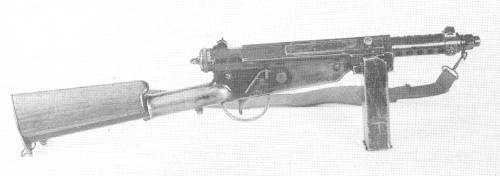
MCEM-1. It was the first sample developed by Harold Turpin after STAN. He did not contain any radical innovations.
The Polish team, led by Lieutenant Podsenkovsky, completed their project second, so their sample was named MCEM-2. It was completely different from the MCEM-1 and was generally different from any other submachine gun created in England before. And not only that, his store was inserted into the handle. He also had a rotating bolt length of 203 mm, advancing on ... 178 mm barrel. That is, the shutter was longer than the barrel! The bolt could be cocked by inserting a finger into the slot above the barrel. The sleeve was located in front of the trigger guard, which was also unusual.
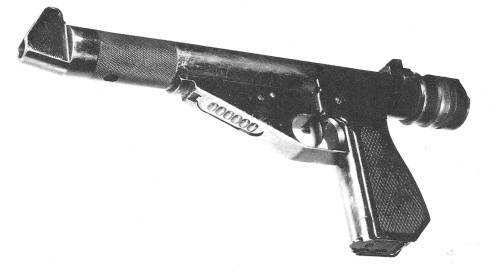
The MCEM-2 was very compact and could be operated with one hand. But because of the short receiver, the rate of fire was about 1000 shots / min, which the Ammunition Committee considered excessive, especially since the magazine of this PP contained all 18 cartridges. Why the designers did not make it more capacity, well, at least on 30 cartridges, not to mention 40, it is not clear.

The MCEM-3 was an improved MCEM-1 model designed to meet the requirements of the General Staff. The retarder rate of fire was removed from it, and the handle for cocking the bolt moved to the left side. The double magazine was replaced with one curved magazine on 20 cartridges and a bayonet mount was added.
MCEM-4 was developed by Lieutenant Kulikovsky, who developed the STAN model Mk.IIS for special operations. The MCEM-4 had a silencer and could well have been a modification of the MCEM-2. MCEM-5 is a mystery, since no records relating to it have been preserved. There is a possibility that they could have been a Viper submachine gun designed by Derek Hatton-Williams, but it is not precisely known.
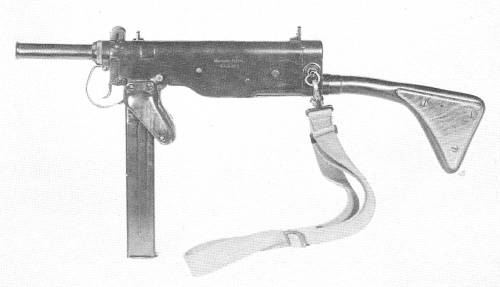
"Viper" Derek Hutton-Williams. Amazing design right? Long receiver, butt, but the trigger on the pistol grip, through which the shop from the German MP-40 passed.
MCEM-6 was the latest model that was submitted to the competition, and was a modernized version of the MCEM-2, which was developed taking into account the previously made comments. It was designed by Lieutenants Ihnatovich and Podsenkovsky. The length of the barrel has been increased by 254 mm, the attachment of the bayonet is added. The weight of the shutter was increased to reduce the rate of fire to 600 shots. / min
Anfield management reviewed all the samples and decided to submit MCEM-2, MCEM-3 and MCEM-6 for testing. They were carried out in September 1946, and all samples, except MCEM-3, were considered unsatisfactory. Therefore, further efforts were focused on MCEM-3.
Meanwhile, in Australia, he started his own project, MCEM, in which the Kokoda submachine gun was created, which was described in the previous article.
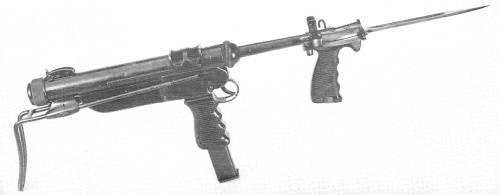
Upgraded "Kokoda" received the designation MCEM-1. This is often confusing, as many believe that the Australian MCEM-1 was the first MCEM model presented by Enfield to the competition. But it is not. The Australian MCEM project and the MCEM project in Enfield are two different projects.
True, its creator Major Hall, who brought him to England, ended up staying there and started developing the EM-3 rifle. Nevertheless, the sample MCEM-1 in England was refined to meet the new specifications of the General Staff and received the designation MCEM-2. On it set the bolt on the right side. Added flame arrester and mount for the bayonet. The rear sight has been replaced by an adjustable one. Ergonomics has been improved with new handles. MCEM-2 was tested in May 1951 of the year and competed with Mk.2 Patchet, Mk.3 BSA and M50 Madsen. MCEM-2 had problems with the extraction of liners, and in addition it broke again. The military did not like this “fragile” submachine gun, and they chose L2A1.
This is how the prudence of the British military and the talent of their engineers gave their armed forces the opportunity to get the most modern small arms and, in particular, the EM-2 rifle at the beginning of the post-war period (see more details on the VO from 31 in March of 2017) year, even adopted by the British army, but due to political pressure from the United States, this rifle has remained empirically. The fact is that the American rifle cartridge 1951 × 7,62 mm has become standard for NATO, which is why all the weapons now had to be designed only for it. And with EM-51 it was very difficult, it was necessary to change ammunition to it. In fact, it was necessary to do everything anew, and time was running out. Therefore, the weapon went to L2A1 (self-loading version of FN FAL).
Submachine gun L2A1 "Sterling"
But before the European submachine guns, the Americans did not care, and the British got their own, national "Sterling". So politics echoes the technique.
To be continued ...
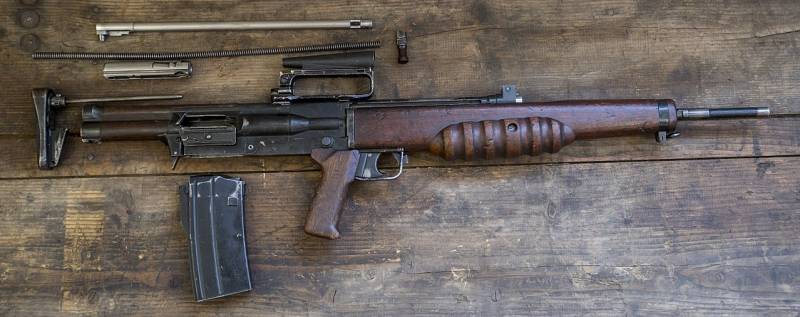
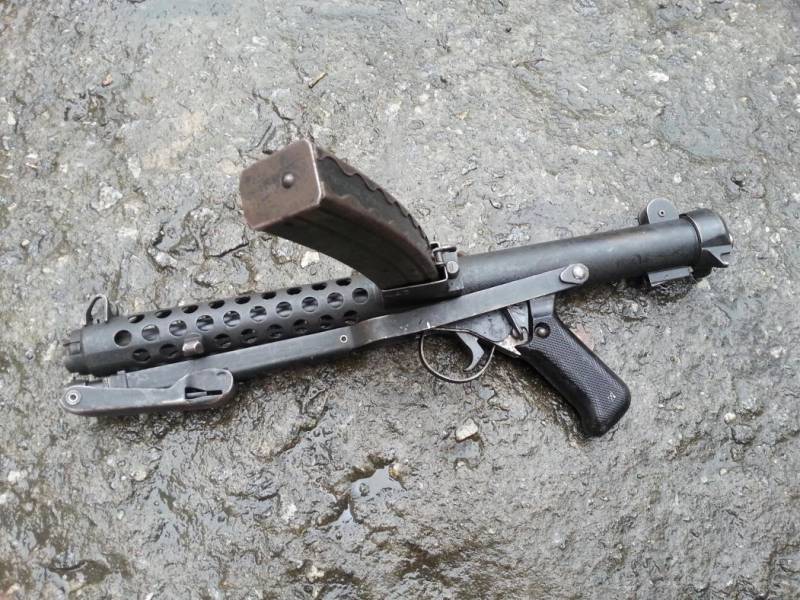
Information